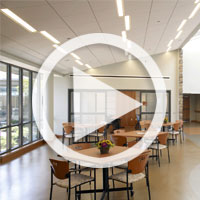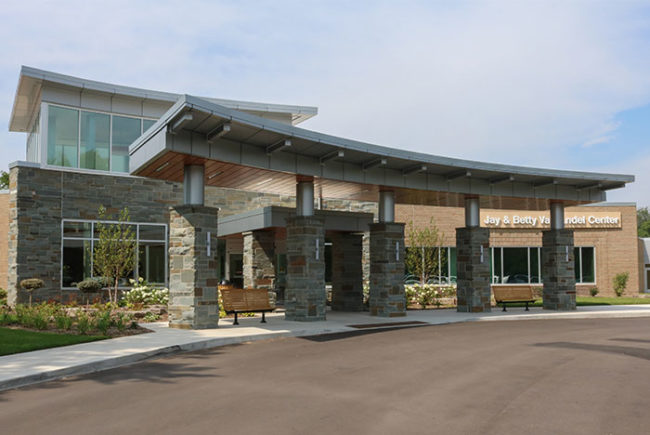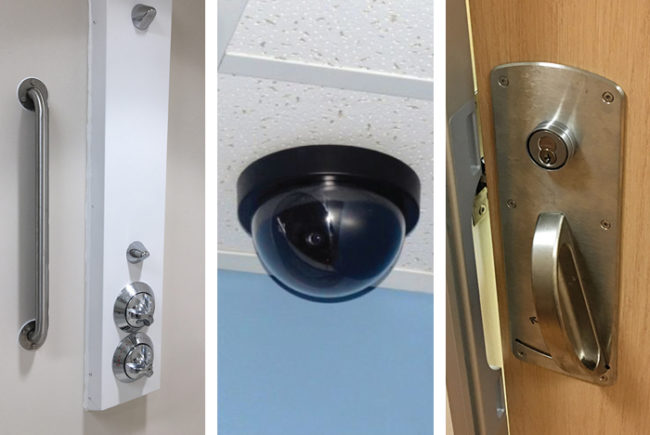About this article
This feature is one of a series of quarterly articles published by Health Facilities Management in partnership with the American Academy of Healthcare Interior Designers. 
Each year, five to seven percent of U.S. adults have serious mental illnesses, which commonly include social phobia, major depression, post-traumatic stress disorder (PTSD), general anxiety, bipolar disorder, Alzheimer’s disease, schizophrenia and obsessive-compulsive disorder.
Additionally, mental health is a central feature of the Affordable Care Act, which includes the expansion of mental health services. Seen as a way to address the historic access issues, this expansion is expected to impact 62 million Americans with benefits that include mental health and substance abuse services starting this year.
Behavioral health settings, which may include psychiatric hospitals, psychiatric units in the general hospital environment, alcohol and addiction treatment facilities, behavioral health clinics and emergency departments (EDs) with psychiatric specialties, must adjust quickly to these realities.
Clinical shifts
The overall number of inpatient beds in all psychiatric hospital settings has declined over the past decades, due to public policies promoting deinstitutionalization and a movement toward treatment in the outpatient setting. As a result, there are psychiatric bed shortages, increased use of EDs for acute episodes and gaps in community-based services.
Outpatient settings can provide lower-cost treatment for this demanding population and a smooth transition of care, which has accounted for an increase in such facilities under construction. In many of these settings, spaces that serve multiple functions such as community-based activities can change public perception about mental health.
Telepsychiatry increasingly is filling in the gaps for more rural and underserved locations as well as extending the ability of physicians to reach more patients and divert behavioral health patients from the ED. In areas that are more densely populated, psychiatric EDs have emerged to specifically address the behavioral health population and reduce the demands on the ED.
The emergence of 23-hour observation units in psychiatric EDs addresses wide swings in levels of traffic and allows clinicians to determine whether a patient should be admitted for inpatient care. Crisis stabilization units are emerging as a solution to acute psychiatric needs, diverting psychiatric or crisis cases away from EDs, diverting adults from jails and juveniles from detention centers.

View "Behavioral health design" Gallery
New treatment protocols
One of the more significant trends impacting design has been a focus on creating a “normalized” environment that reflects the types of situations patients will encounter when they leave the facility. The result has been to incorporate more complex interior spaces into the overall design.
Flexibility in treatment spaces allows for multiple functions and effective space utilization. Community spaces also are designed to be flexible as well as open and social. These spaces serve as locations for meeting with family, having casual interactions and structured therapies, and help to reduce stress associated with inpatient care. They are designed to promote patients’ participation in therapeutic activities and reduce the amount of time spent alone in their rooms.
Access to outdoor spaces also has become an important aspect of therapy. In situations where this is not practical, a view to the outdoors and access to natural light are important in the healing process.
Inpatient environments, in particular, should emphasize efficiency and effectiveness in treatment, because a patient’s length of stay is limited and the goal is to support the individual’s transition to normal life as quickly as possible. As much as possible, the design should give patients a sense of control over their environment through such elements as lighting flexibility, furniture options and space layouts.
Safety and security
The approach to safety has shifted from traditional locked-down units and enclosed nurse stations where patients spend the majority of their time alone in their rooms. The focus is now on providing comfortable environments, with reduction of barriers and with a more residential character. However, the safety of patients and staff is the most critical aspect of design.
Generally, zones of risk, in which patients may cause harm to themselves or others, identify an approach to addressing security needs based upon areas of greatest concern. Zones of high risk are those in which patients are alone and unsupervised, such as the patient room, toilet room or shower, or a seclusion room. Medium-risk zones include those in which patients may have some supervision, are in small groups and are rarely alone, such as in group rooms, day rooms, laundry or the dining room.
Low-risk zones are those in which patients are observed and accompanied, such as in corridors, or where patients are not allowed, such as staff spaces, clean and soiled rooms and housekeeping rooms.
Suicides are the greatest concern and studies recommend that staff have visual access to patients at all times to reduce such incidents. For the design of patient spaces, the objects in the room and design features, such as door knobs, shower curtains, window treatments, ceiling and fixtures, need to be specified to prevent self-harm.
The New York State Office of Mental Health Patient Safety Standards, Materials and Systems Guidelines (www.omh.ny.gov/omhweb/patient_safety_standards) and the National Association of Psychiatric Health Systems Design Guide for the Built Environment of Behavioral Health Facilities (www.naphs.org/quality/design-guide-for-the-built-environment) are two resources that provide useful product and material selection details. The focus of the guides is safety, commonly addressing prevention of ligature hazards and solutions that are ligature-resistant as well as tamper-resistant.
For areas with the highest level of concern, specifications for lighting fixtures, ceiling systems, mirrors and hardware must be considered carefully. For furnishings, solid, securely mounted or built-in furniture may be appropriate where the furniture is meant to be stationary. In other cases, where furniture should be moved to allow for flexibility in the space, consideration of the weight of the piece is important. Most guidelines recommend determining whether furniture or other components in a room cannot be turned into a weapon or be used to hide contraband.
In a recently published report by the Center for Health Design on “Design Research and Behavioral Health Facilities” (www.healthdesign.org/chd/knowledge-repository/design_research_and_behavioral_health_facilities), 115 articles were identified to have sufficient research methodology to be considered when designing for behavioral health facilities. In most cases, the existing guidelines were found to lack sufficient research-based data to support the recommendations. The researchers found that the complexity of behavioral health settings and diagnoses is a possible contributor to the limited research in this area.
Of the studies identified, there is some knowledge that can be useful to design teams. One category, the physical environment and its relationship to social behavior, provides some guidance on patient rooms. Single patient rooms have been found to eliminate roommate issues. Patient privacy is greatly enhanced and there are fewer disruptions and incidents that typically can occur in shared rooms. Private rooms also promote a quieter environment, leading to better sleep for most and lowered levels of agitation for some patients. However, findings differ for children’s environments and some disagreement exists about the safety of private vs. shared rooms. For counseling spaces, on the other hand, social aspects are found to be particularly important because comfort, relationships and communication are essential to improving outcomes.
While much of the available information identifies how to mitigate harm to the patient or staff, studies have emerged that focus on the modification of behaviors through careful and thoughtful approaches to the design.
In an article in the New York Times, evidence-based design researcher Roger S. Ulrich identified violence in psychiatric facilities as a significant area of concern that can be impacted through the design of the facility (www.nytimes.com/2013/01/13/opinion/sunday/building-a-space-for-calm.html). He believes that the goal of facility design should be to reduce stress and, thereby, reduce aggression. Typical inpatient units are not designed for calm, nor do they serve to support a patient’s ability to cope.
A Swedish study cited by Ulrich identified architectural features to reduce stress and aggression that were incorporated into a hospital’s design. A significant reduction in the use of patient restraints was found and the number of patient sedations was considerably lower. Ulrich believes this is an indicator that the environment can positively influence behavior.
Daylight, art, color
The positive impact of daylight has been shown in one study to reduce the length of stay for bipolar patients (www.ncbi.nlm.nih.gov/pubmed/8882914). In this study, 174 patients with clinical depression were assigned to either sunlit or dimly lit rooms. Patients in the sunny rooms stayed an average of 16.9 days compared with 19.5 days for those in the dimly lit rooms.
In a report published by the Coalition for Health Environments Research called “Color in Healthcare Environments” (www.healthdesign.org/chd/research/color-healthcare-environments), the effect of color on health care environments was found to be limited. Despite numerous studies on color, there is no evidence to support a one-to-one relationship between a given color and a given emotional response. Although studies show a mood-color association, there is no evidence of colors being emotional triggers. Individual responses to color vary and are influenced by their culture and physiological and psychological makeup. The trend in behavioral health design is toward the use of brighter, more optimistic color palettes and away from those that are more neutral.
There have been studies that indicate that the use of realistic art can be beneficial in behavioral health settings to reduce patient anxiety and agitation. Results showed that medication dispensed for anxiety and agitation was significantly lower on days when a realistic image of a landscape was displayed. In addition to better outcomes for patients, the cost of medication was compared for the different conditions, establishing a potential financial case for the annual cost savings of $4,000 to $27,000.
Utilizing nature as a healing distraction benefits all ages of patients. By allowing the lines between interior and exterior to blur, the benefits of the outdoors can be brought inside. Similarly, accessible outdoor spaces that carefully address safety concerns can be calming, positive and therapeutic distractions.
Special considerations
Given the range of specialties and ages in behavioral health, it is critical to understand the unique requirements for each to provide a supportive environment. While adult populations may require a higher degree of security, different requirements should be taken into account when designing for other populations.
A growing older population points to increasing numbers of seniors with dementia and mental illness. Older adults often are brought to the ED for care, compounding overcrowding. Because of their ages, these patients have longer lengths of stay, tying up valuable ED space. Additionally, most EDs are not equipped to address the specific needs of the elderly. Geriatric patients, because of their medical and physical limitations, require corridors with handrails to promote ambulation. Lighting and flooring materials should be designed to address limitations of sight and to reduce falls. The transition between materials and contrast levels of flooring color also should be considered.
Facilities for children and adolescents should be designed to address the unique aspects of this age range. Their physical needs and cognitive abilities change over time, giving them different perspectives on their environment. What appeals to a young child may not be engaging for an adolescent, yet the environment needs to respond to all.
Research has shown that positive distractions can enable a child to be more receptive to treatment and to be treated with fewer medications. As much as possible, the environment should strive to provide a sense of normalcy. The patient room becomes a place where a child can have more control over the environment and can personalize his or her space. Play spaces are important tools to reduce tension and anxiety. They can allow for learning and exploration by enabling children to engage with their environment.
Caring for the mental health of military personnel and veterans can be wide-ranging. The issues they face include PTSD, as well as traumatic brain disorders, drug addiction, pain management, sleep disorders and suicide. Though PTSD and traumatic brain injuries represent major mental health care needs, psychological issues more generally go beyond these specific problems.
Many veterans perceive constant threats to themselves and their families, thereby responding differently to environmental conditions. For example, open atrium spaces may be considered threatening to a veteran with combat experience. The Department of Veterans Affairs has embraced a Planetree model of care that focuses on creating more welcoming and family-friendly environments.
A holistic approach
Behavioral health conditions have shifted to a holistic treatment approach in which patients take charge of their healing process through individual and team-based care in a supportive and nurturing environment.
Treatment facilities should be designed to be safe and comfortable, emphasizing personal empowerment and individual dignity, thus becoming a catalyst for improving health care practices and enabling patients to take control of their own healing process.
, AAHID, EDAC, IIDA, ASID, is principal at Cannon Design, Chicago. She can be reached at jstroupe@cannondesign.com.
Mental health center provides healing village
The new 180-bed, 151,000-square-foot Essex County Hospital Center’s Institute for Mental Health Policy, Research and Treatment in Cedar Grove, N.J., seeks to enable all patients to receive appropriate care in a least-restrictive environment.
The design team, led by Cannon Design, began with the goal of creating a facility that challenged conventional perceptions regarding behavioral health care. The center is bright, open and inviting, with forms and materials that speak of movement — a metaphor for transitioning through the healing process and, therefore, to the outside world with speed and purpose.
Organized around the concept of a healing village, it features a series of interconnected multistory buildings, each with specific functions for patient care. At the heart of this village is a central outdoor courtyard, serving as the community green. Enclosing the green is the primary circulation zone that also serves as an indoor social rehabilitation mall and features a cafeteria, chapel, computer lab, library and hair salon.
The main entry is a two-story glass-cube lobby, situated at the junction of the administrative building and the social rehabilitation mall, allowing patients, families, visitors and staff to have a direct view through the lobby into the community green, thus providing cues about how the center is organized.
Facing out to the thick forested portion of the site are “residential neighborhoods,” comprising two three-story buildings each housing six patient care units. For operational efficiency, each unit is standardized with patient rooms that can swing from either private or semiprivate as patient census requires. Units are divided into night zones with bedrooms and hygienic facilities, and day zones with dining, on-unit treatment, recreational and lounge spaces. Each unit has direct access to protected exterior space in the form of either a covered patio or a covered porch.
Selected for their ability to suggest a warm and inviting environment, building materials contribute significantly to the success of the overall palette in suggesting a natural environment.
Behavioral care facility offers range of services
Comprising two interrelated buildings that operate symbiotically to respond to the broadest range of patient needs, the University of Arizona Medical Center’s Behavioral Health Pavilion and Crisis Response Center in Tucson, integrates physically and operationally with an existing acute care hospital and emergency department (ED).
Devised by Cannon Design in association with CDG architects, it features parallel “bars” of patient and support spaces and circulation systems oriented along an east-west axis for optimal sun control. On the site, the buildings are organized around a shared-service court that provides a secure circulation zone for medical staff, law enforcement, courtroom personnel, and patient and material transfers. Internally, each building is organized around a variety of accessible exterior spaces that connect patients and staff directly to nature.
A full continuum of care is provided with acute and subacute inpatient services, outpatient services, crisis assessment and stabilization, and specialized facilities for law enforcement, paramedics and other first responders. Additionally, a courtroom serves patients entering hospitalization through the legal system.
The crisis response center provides a single response point to assess, stabilize and treat patients who do not require emergency or acute psychiatric care, freeing up EDs and inpatient units as well as jails and juvenile detention facilities.
All patients have private rooms with access to views and daylight along with independent access points allowing for segregated movement of patients and staff onto units, greatly enhancing safety. Access to shaded outdoor gardens is provided on all levels for patients, visitors and staff, promoting healing and well-being. The environmentally sensitive architecture enhances comfort for occupants through daylighting and passive climate control. Wayfinding is simplified by the clear organizing strategy and visual connectivity with the outdoors.
Safety and security for patients, visitors and staff have been balanced carefully with openness and connectivity, creating a normalized, yet clinically effective, environment. The design addresses patient dignity, staff retention and visitor comfort through a regionally inspired design that transforms a health facility to a public amenity.




